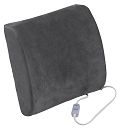
A lumbar cushion is a specially designed ergonomic lumbar orthopedic cushion usually made of firm foam and fiber that sits in the small of the back providing relief and management of low back pain such as sprains and strains, herniated or ruptured discs, sciatica, or traumatic injury aggravated by prolonged periods of sitting in one position at a desk, in a car, lying in bed, or sitting in a wheelchair.


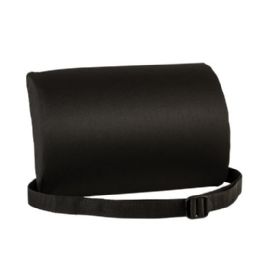
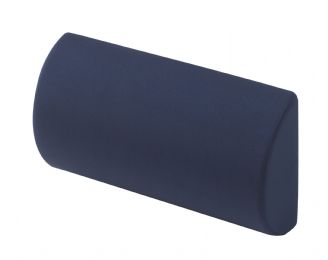
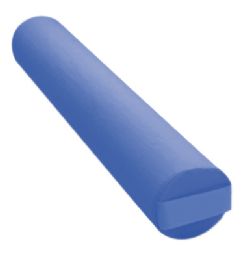
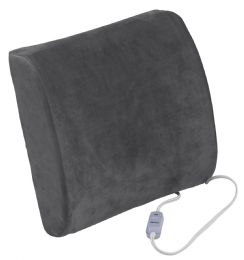
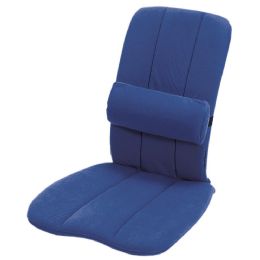










What Causes Low Back Pain?
The majority of low back pain is associated with a term that refers to the normal wear and tear that occurs in the joints, discs and bones of the spine as we get older. This term is called spondylosis. Some examples of this wear and tear of the spine include:
• Sprains and strains
• Intervertebral disc degeneration
• Herniated or ruptured discs
• Radiculopathy
• Sciatica
• Spondylolisthesis
• A traumatic injury
• Spinal stenosis
• Skeletal irregularities
Sprains and strains are responsible for most of the severe back pain people suffer from. They are caused by tearing ligaments, overstretching, or tears occurring with the tendons or muscles. They can happen from lifting something improperly, twisting when lifting, or lifting something that is too heavy. These types of movements can trigger spasms in the back muscles, which can be quite painful.
Intervertebral disc degeneration is one of the most common causes of low back pain, occurring when the rubbery discs between the spinal bones lose their cushion. This is a normal process of aging. In a healthy back, the discs provide height and allow us to bend and flex the lower back, but as we age, these discs break down, losing their cushioning ability.
Herniated or ruptured discs occur when they become compressed and bulge outward, or rupture. This bulging causes low back pain.
Radiculopathy is a condition caused by inflammation, compression, or injury to the spinal nerve root, resulting in numbness, pain, or a tingling sensation that travels to other parts of the body that the nerve serves. It may occur when a herniated or ruptured disc, or spinal stenosis, compresses the nerve root.
Sciatica is a form of radiculopathy. It is caused by compression of the sciatic nerve, which is the large nerve that travels through the buttocks and goes down the back of the leg. This compression causes burning or shock-like low back pain. It is combined with pain through the buttocks and down the leg, and occasionally it can reach the foot. In the most extreme cases when the nerve is pinched, an individual may feel not only pain, but also numbness and muscle weakness in the leg because the nerve signal is interrupted. It can also be caused by a cyst or tumor that is pressing on the sciatic nerve or its roots.
Spondylolisthesis is where a vertebra of the lower spine slips out of place and pinches the nerves that exit the spinal column.
A traumatic injury can injure the tendons, ligaments or muscles resulting in low back pain. This can be instigated from a car accident, playing sports or a fall, causing the spine to become compressed. This compression can induce the disc to herniate or rupture, putting pressure on any of the nerve roots in the spinal cord. When this happens, back pain and sciatica can result.
Spinal stenosis is the narrowing of the spaces of the spine. This puts pressure on the spinal cord and nerves, causing pain or numbness with walking. Over time, this condition can lead to leg weakness and loss of feeling.
Skeletal irregularities include scoliosis, lordosis and other congenital anomalies of the spine. Scoliosis is a curvature of the spine that usually does not cause pain until middle age. Lordosis is an abnormal excessive arch in the lower back.
What are the Risk Factors for Developing Low Back Pain?
There are other risk factors that can increase the chance of developing low back pain. Some of these other factors include:
• Age
• Fitness level
• Pregnancy
• Weight gain
• Occupation
Typically, the first attack of low back pain happens between the ages of 30 and 50. As we grow older, our bones lose their strength and our muscles lose their elasticity. The discs begin to lose fluid and flexibility, decreasing their ability to cushion the vertebrae.
People who are not physically fit tend to have more back pain. Having a weak back and abdominal muscles may not support your spine properly. Those who exercise a lot over the weekend after being inactive all week are also more likely to suffer back injuries than those who make a daily habit of moderate physical activity.
Pregnancy can commonly be accompanied by low back pain. This results from the pelvic changes and alterations in weight, but this pain almost always resolves postpartum.
Quickly gaining significant amounts of weight, or being overweight, can put stress on the back and lead to low back pain.
Having a job that requires pushing, pulling or heavy lifting can lead to injury and back pain. Especially when it involves twisting or vibrating your spine. A desk job or inactive job can also contribute to or lead to low back pain, particularly if the individual sits all day or experiences poor posture in a chair with inadequate back support.
How Can Low Back Pain be Resolved?
Lumbar cushions help support the lower back quickly and conveniently, helping to ease low back pain by promoting proper spine alignment. They provide support for sitting at home, in the office, or in a vehicle to relieve pressure on the lower back and promote good posture.
Specially designed lumbar cushions can be strapped onto a home, office or car chair to stay firmly in place while an individual sits, eliminating the need to readjust the cushion. They can also be applied for use in wheelchairs. Some designs highlight an ergonomic shape that hugs the lower back for increased comfort and support. It is common for people to own more than one lumbar cushion to keep their low back pain under control, one for the home, one for work, one for the car, and one for traveling by air, bus or train.
Rehabmart carries a large assortment of quality lumbar cushions and supports from respected manufacturers and vendors that include BSN Medical, North Coast, Core Products International Inc., Comfort Company, Skwoosh-I-Tec, Independence Medical, Drive Medical, Pivotal Health Solutions and others.
Hulet Smith, OT
Rehabmart Co-Founder & CEO
lb